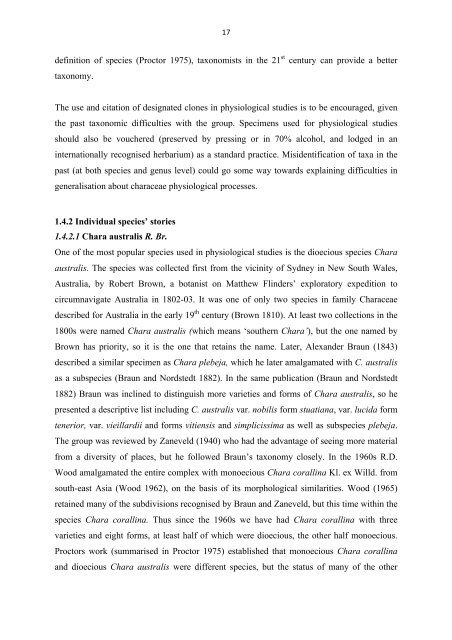Chapter 1: The Characeae Plant
Chapter 1: The Characeae Plant
Chapter 1: The Characeae Plant
You also want an ePaper? Increase the reach of your titles
YUMPU automatically turns print PDFs into web optimized ePapers that Google loves.
17 <br />
definition of species (Proctor 1975), taxonomists in the 21 st century can provide a better<br />
taxonomy.<br />
<strong>The</strong> use and citation of designated clones in physiological studies is to be encouraged, given<br />
the past taxonomic difficulties with the group. Specimens used for physiological studies<br />
should also be vouchered (preserved by pressing or in 70% alcohol, and lodged in an<br />
internationally recognised herbarium) as a standard practice. Misidentification of taxa in the<br />
past (at both species and genus level) could go some way towards explaining difficulties in<br />
generalisation about characeae physiological processes.<br />
1.4.2 Individual species’ stories<br />
1.4.2.1 Chara australis R. Br.<br />
One of the most popular species used in physiological studies is the dioecious species Chara<br />
australis. <strong>The</strong> species was collected first from the vicinity of Sydney in New South Wales,<br />
Australia, by Robert Brown, a botanist on Matthew Flinders’ exploratory expedition to<br />
circumnavigate Australia in 1802-03. It was one of only two species in family <strong>Characeae</strong><br />
described for Australia in the early 19 th century (Brown 1810). At least two collections in the<br />
1800s were named Chara australis (which means ‘southern Chara’), but the one named by<br />
Brown has priority, so it is the one that retains the name. Later, Alexander Braun (1843)<br />
described a similar specimen as Chara plebeja, which he later amalgamated with C. australis<br />
as a subspecies (Braun and Nordstedt 1882). In the same publication (Braun and Nordstedt<br />
1882) Braun was inclined to distinguish more varieties and forms of Chara australis, so he<br />
presented a descriptive list including C. australis var. nobilis form stuatiana, var. lucida form<br />
tenerior, var. vieillardii and forms vitiensis and simplicissima as well as subspecies plebeja.<br />
<strong>The</strong> group was reviewed by Zaneveld (1940) who had the advantage of seeing more material<br />
from a diversity of places, but he followed Braun’s taxonomy closely. In the 1960s R.D.<br />
Wood amalgamated the entire complex with monoecious Chara corallina Kl. ex Willd. from<br />
south-east Asia (Wood 1962), on the basis of its morphological similarities. Wood (1965)<br />
retained many of the subdivisions recognised by Braun and Zaneveld, but this time within the<br />
species Chara corallina. Thus since the 1960s we have had Chara corallina with three<br />
varieties and eight forms, at least half of which were dioecious, the other half monoecious.<br />
Proctors work (summarised in Proctor 1975) established that monoecious Chara corallina<br />
and dioecious Chara australis were different species, but the status of many of the other
















